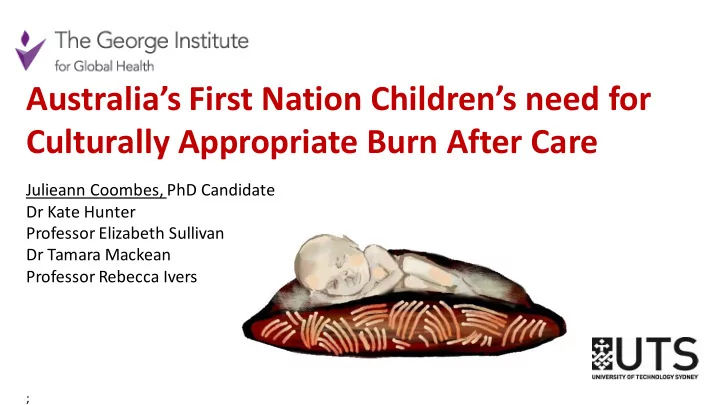

Australia’s First Nation Children’s need for Culturally Appropriate Burn After Care Julieann Coombes, PhD Candidate Dr Kate Hunter Professor Elizabeth Sullivan Dr Tamara Mackean Professor Rebecca Ivers ;
Background There is very limited published research on burns in Australia’s First Nation children . 1 Duke, J., et al, 2.Duke, J., et al,
Participants Eighteen First Nation parents: • South Australia (n=3) • Northern Territory (n=1) • Queensland (n=8) Includes Townsville and Torres Strait Island • New South Wales (n=6)
Methods Family Connections
Knowing, Being and Doing
Yarn rnin ing “Across Australia, Aboriginal people constantly refer to and use yarning in the telling and sharing of stories and information” 3.Bessarab D, 4 Walker Da Dadir irri “To know me is to breathe with me, to breathe with me is to listen deeply, to listen deeply is to connect. It is a sound, the sound of deep calling to deep, down the deep inner springs inside us, we call on it and it calls on us” 5. A reflection by Miriam-Rose Ungunmerr Baumann."(Ungunmerr-Baumann, 2002 )
We found that the journey to recovery is unique to each child depending on distance to health services, family dynamics and the experiences received from health care providers.
Walking together
Preliminary findings ➢ Communication
Preliminary findings ➢ Communication ➢ Child support
➢ Communication ➢ Child support ➢ First Nation Workers
➢ Communication ➢ Child support ➢ First nation Workers ➢ Parking Fees
➢ Communication ➢ Child support ➢ First nation Workers ➢ Parking Fees ➢ Dislocation
➢ Communication ➢ Child support ➢ First nation Workers ➢ Parking Fees ➢ Dislocation ➢ Family Support
➢ Communication ➢ Child support ➢ First nation Workers ➢ Parking Fees ➢ Dislocation ➢ Family Support ➢ Transport
➢ Communication ➢ Child support ➢ First nation Workers ➢ Parking Fees ➢ Dislocation ➢ Family Support ➢ Transport ➢ Racism
The possibility of change
Acknowledgements All First Nation families involved in the study
Dr Kate Hunter Courtney Ryder Professor Rebecca Ivers Sarah Fraser Dr Tamara Mackean Hayley Williams Professor Elizabeth Sullivan
References 1. Duke, J., et al., An assessment of burn injury hospitalisations of adolescents and young adults in Western Australia, 1983 – 2008. Burns, 2012. 38 (1): p. 128-135. 2. Duke, J., et al., A study of burn hospitalizations for children younger than 5 years of age: 1983 – 2008. Pediatrics, 2011. 127 (4): p. e971-e977. 3. Bessarab D, Ng'andu B. Yarning about yarning as a legitimate method in Indigenous research. 2010. 4. Walker, M., et al., “Yarning” as a method for community - based health research with indigenous women: the indigenous women's wellness research program. Health care for women international, 2014. 35 (10): p. 1216-1226. 5. A reflection by Miriam-Rose Ungunmerr Baumann." (Ungunmerr-Baumann, 2002 ) http://nextwave.org.au/wp- content/uploads/Dadirri-Inner-Deep-Listening-M-R- Ungunmerr-Bauman-Refl.pdf
Recommend
More recommend